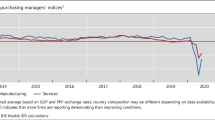Abstract
There were two dramatic changes in United States (U.S.) government policy toward the monetary role of gold in the last 100 years. The first was in 1933-34. Private holdings of gold were nationalized in March 1933. Then, the U.S. Treasury adopted a new parity for the U.S. dollar of $35.00 an ounce at the end of January 1934. Gold production surged, the private demand for gold fell sharply and the U.S. experienced large increases in the foreign demand for U.S. dollar securities. There was a massive flow of gold to the U.S. The second change in U.S. gold policy followed a meeting at Camp David in August 1971 when the U.S. Treasury closed its gold window because of the perception that there might be a run on its gold holdings as they declined toward $10 billion. Some U.S. officials sought to diminish the monetary role of gold, which was accomplished by, in effect, setting the U.S. monetary price at zero. The anticipation of some U.S. officials at the Camp David meeting was that the persistent U.S. payments problem would disappear once foreign currencies no longer had parities in terms of the U.S. dollar. The prices of these foreign currencies would increase and the U.S. trade surplus would become larger. Instead, many foreign central banks became even larger buyers of U.S. dollar securities, which led to a higher price of the U.S. dollar and a U.S. trade deficit. The U.S. international investment position morphed from the world’s largest creditor country to the world’s largest debtor.
Similar content being viewed by others
References
Aliber, R. Z. (2020). Why did the United States Evolve from the Largest International Creditor in 1980 to the Largest International Debtor in 1990? Atlantic Economic Journal, 48(4), 405–411.
Blum, J. M. (1959). From the Morgenthau Diaries. Houghton-Mifflin.
Fleming, I. (2012). Goldfinger, a Thomas and Mercer edition, Las Vegas.
Gilbert, M. (1980). Quest for World Monetary Order: The Gold Dollar System and its Aftermath. New York: John Wiley and Sons.
Gowa, J. (1983). Closing the Gold Window, Domestic Politics and the End of Bretton Woods. Ithaca: Cornell University Press.
Graham, F. D., & Whittlesey, C. R. (1939). Golden Avalanche. Princeton: Princeton University Press.
International Monetary Fund. (2020). Articles of Agreement of the International Monetary Fund. Available at: https://www.imf.org/external/pubs/ft/aa/
Jastram, R., & Leyland, J. (2009). The Golden Constant, The English and American Experience 1560–2007. Cheltenham: Edward Elgar.
Jones, J. H., & Angly, E. (1951). Fifty Billion Dollars: My Thirteen Years with the RFC (1932–1945). New York: The Macmillan Company.
Shultz, G. P., & Dam, K. W. (1997). Economic Policy Beyond the Headlines. Chicago: University of Chicago Press.
Silber, W. L. (2012). Volcker: The Triumph of Persistence. New York: Bloomsbury Press.
Author information
Authors and Affiliations
Corresponding author
Additional information
Publisher's Note
Springer Nature remains neutral with regard to jurisdictional claims in published maps and institutional affiliations.
Rights and permissions
About this article
Cite this article
Aliber, R.Z. Auric Goldfinger, Henry Morgenthau, and Camp David: August 1971. Atl Econ J 49, 117–126 (2021). https://doi.org/10.1007/s11293-021-09720-7
Accepted:
Published:
Issue Date:
DOI: https://doi.org/10.1007/s11293-021-09720-7




